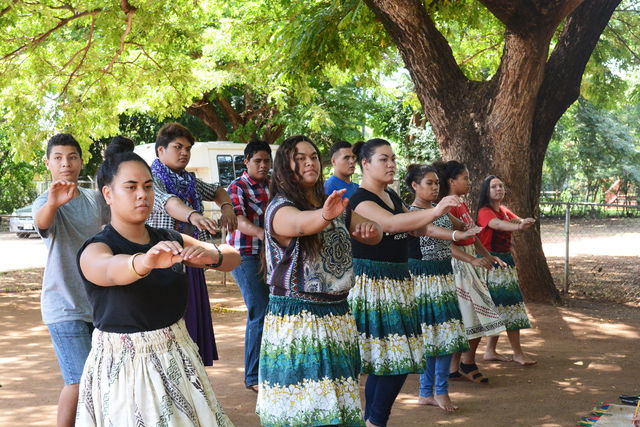KEKAHA — It takes dedication and the right set of tools to get the job done and the awards that line the walls of Kula Aupuni Niihau A Kahelelani Aloha, a public charter school in Kekaha, show the school has
KEKAHA — It takes dedication and the right set of tools to get the job done and the awards that line the walls of Kula Aupuni Niihau A Kahelelani Aloha, a public charter school in Kekaha, show the school has both.
“We’ve been at the top of all of the high schools on Kauai a few times,” said principal Hedy Sullivan, who has been with the school since its inception in 1999.
The school started in the park that year and moved into its current building in 2004. Since then, they’ve been slowly adding the pieces and parts that make up the school, like a cafeteria and a computer room. They’ve built the place from the ground up and Sullivan said there wasn’t a guidebook for doing it.
“We’ve had our struggles and there was no class called 101 Charter Schools when we created the school, but we’re blessed,” she said.
Recently, it was named the No. 1 high school on the island for the 2013/2014 school year.
Kula Aupuni Niihau A Kahelelani Aloha is a K-12 bilingual school that teaches kids core subjects in English, but also focuses on native Hawaiian language and culture. It caters mostly to children from the island of Niihau, though all children are welcome to attend.
The school has 56 kids enrolled. This year, there is no kindergarten class because Sullivan couldn’t find a teacher. The rest of the classes are combined, with several grades in one classroom.
“Differentiation is key there,” Sullivan said. “Combined classes aren’t easy, but a good teacher can do it.”
All of the school is eligible for Title 1 funding, which means the kids who attend are from families that qualify with the federal government as economically disadvantaged.
“A lot of their parents have no jobs,” Sullivan said, “and in the culture that these kids come from, education isn’t the main focus. Family is the main focus. A lot of these parents made it through the eighth grade.”
Because she has a large amount of students who qualify for Title 1, Sullivan has access to Title 1 funding.
“I don’t always take the Title 1 money,” Sullivan said. “It comes with a lot of requirements and it’s not worth it for myself or for my board (of directors).”
When she does use the money, which is usually around $18,000 to $20,000 annually, it is always dedicated to building the technology base at the school.
“We use a lot of technology and that helps the kids see new things and keeps them a little more focused,” said Nadine Smith, who teaches a combination class of first, second and third grade at the school. “I use it every day and it’s so necessary.”
Smith has a Smart Board and several laptops in her classroom, as do all of the classrooms at the school. Teachers use them to keep up with the new common core standards and the Smarter Balanced Assessment, as well as to teach lessons.
In addition to having the right technology tools, Smith keeps her lessons interactive and that has been the key to keeping the kids engaged and learning.
“We have games and interactive lessons, we dance,” Smith said. “We get up and move around and have fun.”
Niryanne Santiago, a 15-year-old junior at the school, said her favorite class is hula, where she and her fellow classmates get to learn the traditional dance, but she spends hours outside of class studying in order to keep her grades high.
Niryanne said she is motivated to do well in school so she can get a good job when she graduates college.
“I want to be an ultrasound technician when I grow up,” Niryanne said. “I want to be able to graduate high school with my associates’ degree already.”
Kalae Chandler, 12, a seventh-grader, said he wants to do well in school for the same reason.
“I want to go to college so I can get a job and be an engineer,” Kalae said.
Both Niryanne and Kalae said their keys to success are working hard and listening during class.
Providing a good future for kids is a passion for Sullivan, who sees the school as a family.
“That’s how we survive here,” Sullivan said. ‘We’re a family and we watch out for each other and help each other when we’re struggling.”


